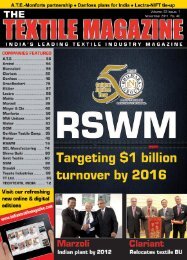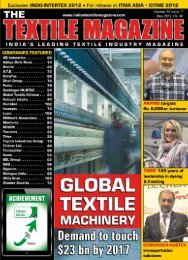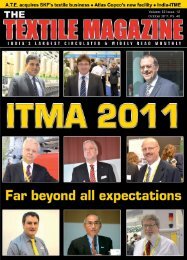policy initiatives - Textile Magazine
policy initiatives - Textile Magazine
policy initiatives - Textile Magazine
You also want an ePaper? Increase the reach of your titles
YUMPU automatically turns print PDFs into web optimized ePapers that Google loves.
technology<br />
Standard 1000, the successful testing<br />
for nonylphenols, nonylphenol-<br />
(1-9)-ethoxylates, octylphenols and<br />
octylphenol-(1-2)-ethoxylates will<br />
in future also form a prerequisite for<br />
product certification according to<br />
OEKO-TEX Standard 100.<br />
The limit values that apply to<br />
all four product classes are nonylphenols:<br />
100 ppm, octylphenols:<br />
100 ppm, total nonylphenol-(1-9)-<br />
ethoxylates: 1000 ppm, and total<br />
octylphenol-(1-2)-ethoxylates: 1000<br />
ppm.<br />
The tests begin with the publication<br />
of the new Standard. In order<br />
to allow companies an adequate<br />
time-frame to implement any necessary<br />
changes in their production, the<br />
requirements will only come into<br />
force definitively after a transition<br />
period on April 1, 2013. This regulation<br />
does not apply to companies<br />
certified according to OEKO-TEX<br />
Standard 1000, as they already comply<br />
with the required criteria.<br />
• The limit value for extractable<br />
chromium is set at 10 mg/kg for<br />
leather products in product class IV.<br />
This exception to the usual chromium<br />
limit values for textile articles<br />
corresponds to the best available<br />
technology on the market at the current<br />
time and does not pose any toxicological<br />
risk when such products<br />
are used as intended.<br />
In addition to the new test parameters,<br />
the scope of the control tests on<br />
the OEKO-TEX certified products<br />
carried out throughout the world is<br />
being extended to cover 20 per cent<br />
of all certificates issued annually in<br />
future, as opposed to the minimum<br />
15 per cent tested to date. In practice,<br />
over recent years, an average of<br />
18 per cent of certificates have been<br />
tested using product samples taken<br />
from the shops at the expense of the<br />
OEKO-TEX Association.<br />
A new complement to the OEKO-<br />
TEX Standard 100 is now also available,<br />
on the basis of which it will be<br />
possible to certify special products<br />
such as tents, prams, office chairs or<br />
rucksacks according to OEKO-TEX<br />
Standard 100 in future.<br />
•<br />
Delhi meet discusses major issues<br />
With 11,283 certificates issued in<br />
the last year alone, and more than<br />
9,500 companies involved in the<br />
scheme in over 90 countries, the<br />
OEKO-TEX Standard 100 has once<br />
again confirmed its position as the<br />
world’s leading certification scheme<br />
for textiles tested for harmful substances.<br />
This was the conclusion at the<br />
meeting of the heads of OEKO-<br />
TEX institutes, which, in view of<br />
the growing number of certificates<br />
issued to production companies in<br />
Asian countries such as India, took<br />
place in Delhi for the first time on<br />
November 7 and 8 last. As always,<br />
the agenda included decision-making<br />
on the new version of the OE-<br />
KO-TEX list of criteria, and internal<br />
agreement by the 15 OEKO-TEX<br />
member-institutes on the existing<br />
quality control procedures to en-<br />
sure a consistent standard of testing<br />
and compliance with the required<br />
product quality, as well as on the<br />
question of international trademark<br />
protection for the “Confidence in<br />
<strong>Textile</strong>s” label.<br />
Another focus for discussion at the<br />
meeting was an analysis of the company<br />
audits that were introduced in<br />
2010. Since April last year, said the<br />
OEKO-TEX General Secretary, Dr.<br />
Jean-Pierre Haug, the OEKO-TEX<br />
Association had already visited over<br />
2,000 companies internationally as<br />
part of the certification process, in order<br />
to give them customised support<br />
with implementing the OEKO-TEX<br />
requirements regarding operational<br />
quality control. “When we carry out<br />
company audits on the spot, we can<br />
clarify any unresolved issues faceto-face<br />
with the quality managers,<br />
and so help the companies to gain<br />
maximum value for money from the<br />
certification process.”<br />
It was therefore unanimously<br />
agreed by the General Managers of<br />
the OEKO-TEX institutes that global<br />
company monitoring would continue.<br />
The aim is for all certificateholders<br />
to have been successfully<br />
audited by 2013.<br />
The OEKO-TEX representatives<br />
also unanimously confirmed the initiative<br />
by the technical OEKO-TEX<br />
Executive Committee to introduce<br />
checking for alkylphenolethoxylates<br />
(APEOs) such as nonylphenol as a<br />
requirement for product certification<br />
under the OEKO-TEX Standard 100<br />
in future. From January, nonylphenol,<br />
nonylphenol-(1-9) ethoxylates,<br />
octylphenol and octylphenol-(1-2)<br />
ethoxylates will be included in the<br />
OEKO-TEX list of criteria. So<br />
from April 2013 companies will be<br />
56 | The <strong>Textile</strong> <strong>Magazine</strong> jANUARY 2012






